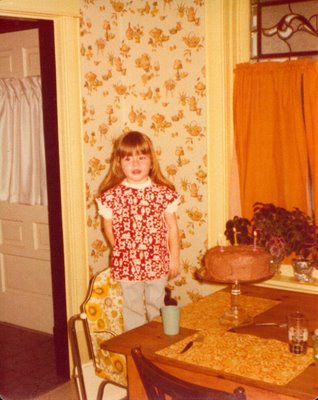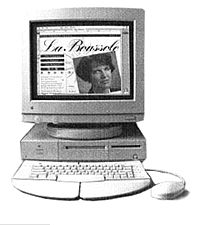 MACINTOSH CENTRIS 610
MACINTOSH CENTRIS 610This byte of Apple's history from Wired's,"30 Years of Apple Products."
 Ha! I was stumbling around on the web this afternoon and came across a post titled, "Creating a Site Schematic" on Joshuaink.com -- and it struck a major chord. I found myself in just this same situation recently... oh, say around... yesterday. Here's an excerpt:
Ha! I was stumbling around on the web this afternoon and came across a post titled, "Creating a Site Schematic" on Joshuaink.com -- and it struck a major chord. I found myself in just this same situation recently... oh, say around... yesterday. Here's an excerpt:It's not what we were expecting...
"...the client says nothing until the launch [of the website] and then realises they had actually wanted something different after all.
The bottom line is, I have had to learn, sometimes the hard way, that although a client may nod and agree with everything you are saying, they could well be thinking about the holiday in the Caribbean they are about to take, and it won't be until half way through the project that they will reveal the truth, ooooh! is that what you meant, I misunderstood can we change it?"
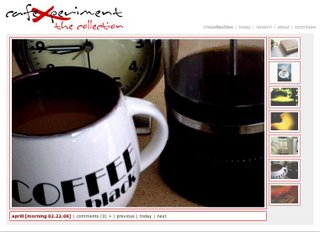
 Yay! I am officially part of the Cafe Experiment. It's a veritable eyeful (?) of delicious coffee from around the world!
Yay! I am officially part of the Cafe Experiment. It's a veritable eyeful (?) of delicious coffee from around the world! POWERBOOK 270c
POWERBOOK 270c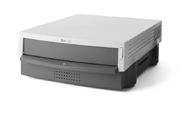 POWERBOOK DUODOCK
POWERBOOK DUODOCK
"The DuoDock allowed any Duo to immediately expand its features. The DuoDock included a larger hard drive, more VRAM and more input and output ports. The DuoDock and its successors allowed the Duo product line to become office desktop models. The DuoDock was replaced in May 1994 by the DuoDock Plus and the DuoDock II." (photo credit: John Greenleigh/Flipside Studios)
•scratched my dog's belly for a couple minutes.
•went downstairs and made coffee, noticing supply is critically low.
•ate an almond sweet & salty bar.
•checked my emails. Just one.
•showered.
•called a/g & worked on a client's site.
•called client. Discussed site.
•ate exactly 3 bites of coleslaw.
•walked the dog. Not for very long -- he was lazy.
•went to the drugstore. Purchased hairdye & de-frizzer cream.
•tried on funky sunglasses. A patron commented they looked nice so I bought 'em.
•returned home. Ate a piece of cold pizza & potato salad.
•called my brother. Waited on hold for several minutes. Ended up getting voicemail.
•im'ed with m. briefly.
•called a/g. We went online to order some e.l.f, but shopping carts weren't working.
•hung up with a/g and took screenshots of my cafeexperiment.com submissions.
•opened Blogger Dashboard and commenced creating this post.
•as for what's yet to come today...? ...it is all just a glorious, exciting mystery yet to unfold!
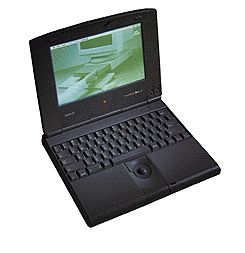 POWERBOOK DUO 210
POWERBOOK DUO 210CPU
CPU: Motorola MC68030
CPU Speed: 25 MHz
Bus Speed: 25 MHz
Data Path: 32 bit
ROM: 1 MB
RAM Type: unique
Minimum RAM Speed: 100 ns
Onboard RAM: 2 MB
RAM slots: 1
Maximum RAM: 8 MB
Level 1 Cache: 0.5 kB
Expansion Slots: modem
Video
Screen: Passive Matrix
Max Resolution: 1 bit 640x400
Storage
Hard Drive: 40-120 MB
Floppy Drive: 1.4 MB SuperDrive
Input/Output
ADB: 1
Serial: 2
SCSI: HDI-30
Audio Out: mono 8 bit mini
Audio In: mono 8 bit mini
Speaker: mono
Miscellaneous
Codename: Colt 45
Gestalt ID: 54
Power: 17 Watts
Dimensions: 2.25" H x 11.25" W x 9.3" D
Weight: 6.8 lbs.
Minimum OS: 7.0.1
Maximum OS: 7.6.1
Introduced: August 1992
Terminated: June 1993
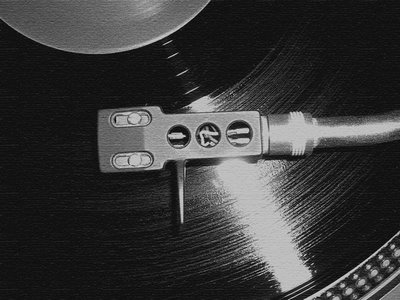 I was blog-hopping this morning and came across "Nanny In New York." I don't have kids, but I have worked with them - and well, she is in New York - so I figured there'd probably be a couple of good stories in there. There was one post titled, "The Power of Music," where she recounts listening to music with her little charges, and how their resounding favourite track that they all uproariously responded to was, "Hey Ya" by Outkast. She comments that when was young, she enjoyed the music her father had listened to, and it got me to thinking back to the music that was most often played in my household when I was young...
I was blog-hopping this morning and came across "Nanny In New York." I don't have kids, but I have worked with them - and well, she is in New York - so I figured there'd probably be a couple of good stories in there. There was one post titled, "The Power of Music," where she recounts listening to music with her little charges, and how their resounding favourite track that they all uproariously responded to was, "Hey Ya" by Outkast. She comments that when was young, she enjoyed the music her father had listened to, and it got me to thinking back to the music that was most often played in my household when I was young...My older brother was a huge influence over my taste in music at that time, too, and when we hit on a favourite, we played it to death. We often played "air band," with our red, orange and yellow shag rug as our stage. Of course, we were a 2-piece: a guitarist (tennis racket) and a drummer (stacks of throw-pillows). We took it rather seriously, and if I do say so myself, we pulled off some of the most rockin' air-performances of all time in that rec room on Victoria Street. Our set list looked something like this:
"For Those About To Rock" AC/DC
"Here She Comes Again" - The Cars
"Don't Try Suicide" - Queen
"The Logical Song" - Supertramp
"Heat Of The Moment" - Asia
"The Stroke" - Billy Squire
"I Can Feel It Coming In The Air Tonight" - Phil Collins (that drum solo!)
"Hotel California" - The Eagles
"You Took The Words Right Out Of My Mouth" - Meat Loaf
"Crazy Train" - Ozzy Osbourne
"My Sharona" - The Knack
"Modern Love" - David Bowie
"Don't You Want Me" - Human League
"Tainted Love" - Soft Cell
"Turning Japanese" - The Vapors
"Drugs In My Pocket" - The Monks
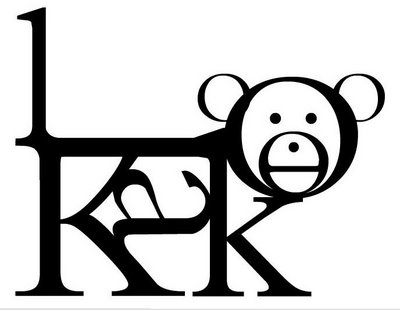
 Awww, these little "Prickie" buttons are the cutest little things ever, aren't they? I just love, love, love them and it's such a great way for artists to distribute their work. I wish I had a button making machine, then I would make cute, itty-bitty little buttons. But I don't have a button machine... so, enter Prickies! (tee hee, I said Prickies!)
Awww, these little "Prickie" buttons are the cutest little things ever, aren't they? I just love, love, love them and it's such a great way for artists to distribute their work. I wish I had a button making machine, then I would make cute, itty-bitty little buttons. But I don't have a button machine... so, enter Prickies! (tee hee, I said Prickies!)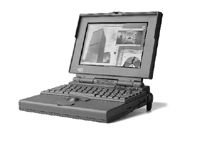 POWERBOOK 160
POWERBOOK 160CPU
CPU: Motorola MC68030
CPU Speed: 25 MHz
Bus Speed: 25 MHz
Data Path: 32 bit
ROM: 1 MB
RAM Type: unique
Minimum RAM Speed: 100 ns
Onboard RAM: 2 MB
RAM slots: 1
Maximum RAM: 8 MB
Level 1 Cache: 0.5 kB
Expansion Slots: modem
Video
Screen: Passive Matrix
Max Resolution: 1 bit 640x400
Storage
Hard Drive: 40-120 MB
Floppy Drive: 1.4 MB SuperDrive
Input/Output
ADB: 1
Serial: 2
SCSI: HDI-30
Audio Out: mono 8 bit mini
Audio In: mono 8 bit mini
Speaker: mono
Miscellaneous
Codename: Colt 45
Gestalt ID: 54
Power: 17 Watts
Dimensions: 2.25" H x 11.25" W x 9.3" D
Weight: 6.8 lbs.
Minimum OS: 7.0.1
Maximum OS: 7.6.1
Introduced: August 1992
Terminated: June 1993
 POWERBOOK 100
POWERBOOK 100"The first of Apple's truly portable Mac's, the PowerBook 100 had basically the same processor as the old Mac Portable. The 100 was well received despite its slow processor, passive-matrix screen, and lack of internal floppy drive. It originally sold for $2,500 The PowerBook 100 was released alongside the 140 and the 170. While these two models were based on the same motherboard, the 100 had a simpler motherboard design, and was designed and manufactured by Sony for Apple." (photo credit: John Greenleigh/Flipside Studios)
CPU
CPU: Motorola MC68HC000
CPU Speed: 16 MHz
Bus Speed: 16 MHz
Data Path: 16 bit
ROM: 256 kB
RAM Type: unique
Minimum RAM Speed: 100 ns
Onboard RAM: 2 MB
RAM slots: 1
Maximum RAM: 8 MB
Expansion Slots: modem
Video
Screen: Passive Matrix
Max Resolution: 1 bit 640x400
Storage
Hard Drive: 20-40 MB
Floppy Drive: external, HDI-20 port
Input/Output
ADB: 1
Serial: 1
SCSI: HDI-30
Audio Out: mono 8 bit mini
Speaker: mono
Miscellaneous
Codename: Asahi, Derringer, Rosebud
Gestalt ID: 24
Power: 17 Watts
Dimensions: 1.8" H x 11" W x 8.5" D
Weight: 5.1 lbs.
Minimum OS: 7.1
Maximum OS: 7.5.5
Introduced: October 1991
Terminated: August 1992
 I stumbled across a great illustrator today. Her name is Cybèle, and she seems to be quite a busy little bee. Besides busying herself with impressive illustrations for clients such as Liz Collins, Sweet 16, Dolly, Dwell and GQ Japan to name a few, she maintains 2 sites and 2 blogs. Her freelance portfolio can be found at walkcycle.com and her newest site is Cybèlicious. From those sites, you'll be able to navigate to her blogs, "Waagblog" and the newborn, "Cybèlicious Sketchblog." Quite a talent! Way to go, Cybèle!
I stumbled across a great illustrator today. Her name is Cybèle, and she seems to be quite a busy little bee. Besides busying herself with impressive illustrations for clients such as Liz Collins, Sweet 16, Dolly, Dwell and GQ Japan to name a few, she maintains 2 sites and 2 blogs. Her freelance portfolio can be found at walkcycle.com and her newest site is Cybèlicious. From those sites, you'll be able to navigate to her blogs, "Waagblog" and the newborn, "Cybèlicious Sketchblog." Quite a talent! Way to go, Cybèle!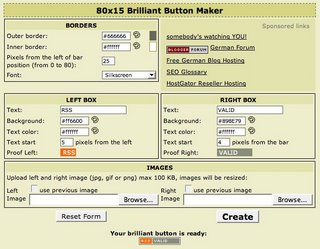 Make brilliant buttons with the Brilliant Button Maker! It's 100% certified brilliant-button goodness for your website or blog! Brought to you by the fine folks at Luca Zappa!
Make brilliant buttons with the Brilliant Button Maker! It's 100% certified brilliant-button goodness for your website or blog! Brought to you by the fine folks at Luca Zappa! Luxembourg-based BIZART specializes in visual communication -- and that's clear from their mesmerizing slideshow set to laid-back, trippy grooves. They definitely have a unique approach to presenting their information... grainy b&w photos of airports, runways, plane interiors, each with internal-dialogue-train-of-thought-esque captions like, "teleportaion would be so cool," "...John said getting there is half the fun," and "i'd kill for a double-shot latte." Click FLIGHTS to see their work, or BOOKING to get their contact info. Clever, clever.
Luxembourg-based BIZART specializes in visual communication -- and that's clear from their mesmerizing slideshow set to laid-back, trippy grooves. They definitely have a unique approach to presenting their information... grainy b&w photos of airports, runways, plane interiors, each with internal-dialogue-train-of-thought-esque captions like, "teleportaion would be so cool," "...John said getting there is half the fun," and "i'd kill for a double-shot latte." Click FLIGHTS to see their work, or BOOKING to get their contact info. Clever, clever.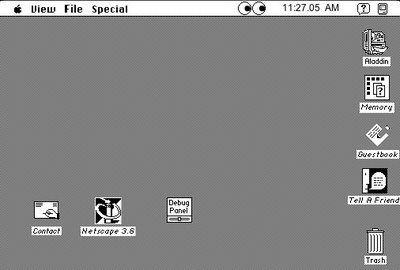 Curious to experience a Mac circa 1990 (just like the ones most recently featured in my "apple a day" posts?) Want to play Snake, Asteroids, Space Invaders, and Pong? Wanna doodle in MacDraw, run First Aid, or see that classic AfterDark screensaver do it's thang? If you're a mac fan, you'll appreciate this lovingly-created simulation of OS 7. It's pretty darn clever. Don't be afraid to click around -- you can pretty much do everything on this simulation but trash stuff -- even open Netscape 3.0 and visit a a few Apple-related sites. I've fiddled with it a few times now, and what I want to know is, whatever became of the googly eyes? Cheesy? I think not. I heart how they follow my cursor around. I've always felt that my macs have their own personalities, so seeing it's little eyes track my every move would be such fun indeed!
Curious to experience a Mac circa 1990 (just like the ones most recently featured in my "apple a day" posts?) Want to play Snake, Asteroids, Space Invaders, and Pong? Wanna doodle in MacDraw, run First Aid, or see that classic AfterDark screensaver do it's thang? If you're a mac fan, you'll appreciate this lovingly-created simulation of OS 7. It's pretty darn clever. Don't be afraid to click around -- you can pretty much do everything on this simulation but trash stuff -- even open Netscape 3.0 and visit a a few Apple-related sites. I've fiddled with it a few times now, and what I want to know is, whatever became of the googly eyes? Cheesy? I think not. I heart how they follow my cursor around. I've always felt that my macs have their own personalities, so seeing it's little eyes track my every move would be such fun indeed! QUADRA 700
QUADRA 700"The Quadra 700 was powered by a 25 MHz 68040 processor, which included an FPU. It was the first in a new family of Macs, and was the first Mac to ship in a tower case (a IIcx case on its side, with the label rotated 90 degrees). The Quadra 700 was priced at $6,000." (photo credit: Upgrading and Repairing Macs)
CPU
CPU: Motorola MC68040
CPU Speed: 25 MHz
FPU: integrated
Bus Speed: 25 MHz
Data Path: 32 bit
ROM: 1 MB
RAM Type: 30 pin SIMM
Minimum RAM Speed: 80 ns
Onboard RAM: 4 MB
RAM slots: 4
Maximum RAM: 68 MB
Level 1 Cache: 8 kB
Expansion Slots: 2 NuBus, 1 PDS
Video
VRAM: 512 kB - 2 MB (six sockets)
Max Resolution: 1152x870
Video Out: DB-15
Storage
Hard Drive: 80-400 MB
Floppy Drive: 1.4 MB SuperDrive
Input/Output
ADB: 2
Serial: 2
SCSI: DB-25
Audio Out: stereo 8 bit mini
Audio In: mono 8 bit mini
Speaker: mono
Networking
Ethernet: AAUI-15
Miscellaneous
Codename: Shadow, Spike, IIce, Evo 200
Gestalt ID: 22
Power: 50 Watts
Dimensions: 5.5" H x 11.9" W x 14.4" D
Weight: 13.6 lbs.
Minimum OS: 7.1
Maximum OS: 8.1
Introduced: October 1991
Terminated: March 1993
This byte of Apple's history from, "30 Years of Apple Products."
previously on i heart to blog
- mother's my new mother now
- sunday scribblings - hi, my name is...
- the heart wants what it wants
- yeun hearts serenity now
- mmm... mStand
- photo friday 05•18•07 - large
- thursday challenge - motion
- eyes turned upward... on my desktop
- i heart linnea gits gifts
- photo friday 04•27•07 - relaxation
i heart archives
- 03.12.2006
- 03.19.2006
- 03.26.2006
- 04.02.2006
- 04.09.2006
- 04.16.2006
- 04.23.2006
- 04.30.2006
- 05.07.2006
- 05.14.2006
- 05.21.2006
- 05.28.2006
- 06.04.2006
- 06.11.2006
- 06.18.2006
- 06.25.2006
- 07.02.2006
- 07.09.2006
- 07.16.2006
- 07.23.2006
- 07.30.2006
- 08.13.2006
- 08.20.2006
- 08.27.2006
- 09.17.2006
- 10.08.2006
- 10.15.2006
- 11.05.2006
- 11.19.2006
- 12.03.2006
- 12.17.2006
- 01.07.2007
- 02.11.2007
- 02.18.2007
- 03.11.2007
- 03.18.2007
- 03.25.2007
- 04.01.2007
- 04.08.2007
- 04.15.2007
- 04.22.2007
- 05.13.2007
- 05.27.2007
- 07.08.2007
- 09.23.2007
- 10.07.2007
i heart site picks
- the skinny
- stuck in the 80's
- candykiller
- misprinted type
- gigposters.com
- juju's delivery service
- j. otto seibold
- the creative bushido
- thinking with type
- brian rea
- bizart
- just for the F of it
- pixel gasoline
- chromasia
- no! spec
i heart goodies
- veer activity books
- dark horse buffy desktop
- i heart 80's videos
- 50 AIGA symbols
- free site?
- culture fool challenge
- essence of rabbit
- j. otto's bubblesoap
- grandPerspective
- behind the typeface: cooper black
- pantone spring color report
- brilliant button maker
- fuse fun bouncy ball
- monochrom
- 25 best free fonts
- moccu e-cards
i heart working for
i heart these daily
i heart & want to marry
- iso50
- moccu
- s. britt
- so fake
- grotesk
- otterball
- four5one
- candy killer
- fiona hewitt
- sky and snow
- homestarrunner
- charles s. anderson
- design bureau of amerika
i heart thursday challenge
i heart photo friday
- relaxation
- heat
- remarkable
- health
- automotive
- home
- masterpiece
- adolescence
- famous
- golden
- postsecret
- china 2006
- the apple blog
- doing it to death
- all about the pretty
- le moleskine à beleg
- papeis por todo o lado
- secret life of shi sensei
- tamar graphics connection
i heart sunday scribblings
i heart blogworthiness
i heart procrastinating
i heart heavy rotation
i heart books on the go
i heart to covet
- EQ3
- moo
- lush
- (RED)
- relish
- holga
- ugly dolls
- matt & nat
- miso pretty
- sugar paper
- lovely design
- the cupcake shoppe
- pantone flight stools
- wallpaper from the 70's
- red maloo laptop sleeves
i heart learning css
- css vault
- css import
- css beauty
- css lookup
- 10 css tricks
- css examples
- css bookmarks
- css try it editor
- max design css
- css zen garden
- mandarin design
- holy css zeldman
- eric meyer on css
- brainjar css positioning
- css from the ground up
- css web design from scratch

a t o m . 0 . 3

